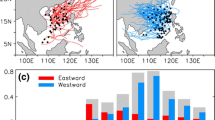Abstract
Intensity variations of the SE-NW-oriented tropical cyclones (TC) in the East China Sea (ECS) passing over the Kuroshio are studied using multi-year high-resolution sea surface temperature data, the tropical cyclone data, and the global reanalysis dataset. The statistical results show that there are 81 TCs passing over the Kuroshio from the southeast in the East China Sea, over 68 years from 1949 to 2016. In terms of the change of the atmospheric pressure in the center of the TC, there are three categories: 31 TCs are intensified, 28 maintain their intensities, and 22 weakened. Significant seasonal differences are presented in the distribution. In the analysis on the intensified TCs, it is found that the TCs in the range where the center translational speed is from 1 m/s to 8 m/s and the distance from the Kuroshio main axis is from 10 km to 75 km are intensified more significantly. The analysis of three specific examples of TCs show that the stronger characteristics of the Kuroshio warm water in the ECS, the greater the intensity increase of such tropical cyclones.
Similar content being viewed by others
Data Availability Statement
The datasets analyzed during the current study are available in the REMSS Analysis (Sea surface temperature data is the daily data provided by the National Oceanographic Data Center of the United States, download from: ftp://ftp.nodc.noaa.gov/pub/data.nodc), the China Meteorological Administration (CMA, http://www.typhoon.org.cn/), and the Global Drifter Program (GDP, download from: http://www.aoml.noaa.gov/phod/dac/gdp_information.php).
References
Bright R, Xie L, Pietrafesa L. 2002. Evidence of the Gulf Stream’s influence on tropical cyclone intensity. Geophysical Research Letters, 29 (16): 1 801.
Chang Y, Liao H, Lee M et al. 2008. Multisatellite observation on upwelling after the passage of typhoon Hai-Tang in the southern East China Sea. Geophysical Research Letters, 35 (3): L03612.
Chen D K, Lei X T, Wang W, Wang C H, Han G J, Zhou L. 2013. Upper ocean response and feedback mechanisms to typhoon. Advances in Earth Science, 28 (10): 1 077–1 086. (in Chinese with English abstract)
Dong C M, Liu Y, Lumpkin R, Lankhorst M, Chen D K, Mcwilliams J C, Guan Y P. 2011. A scheme to identify loops from trajectories of oceanic surface drifters: an application in the Kuroshio extension region. Journal of Atmospheric and Oceanic Technology, 28 (9): 1 167–1 176.
Emanuel K. 2001. Contribution of tropical cyclones to meridional heat transport by the oceans. Journal of Geophysical Research: Atmospheres, 106 (D14): 14 771–14 781.
Galarneau T J, Davis C A, Shapiro M A. 2013. Intensification of hurricane Sandy (2012) through extratropical warm core seclusion. Monthly Weather Review, 141 (12): 4 296–4 321.
Lin I I, Wu C C, Emanuel K A, Lee I H, Wu C R, Pun I F. 2005. The interaction of super typhoon Maemi (2003) with a Warm Ocean Eddy. Monthly Weather Review, 133 (9): 2 635–2 649.
Lumpkin R, Grodsky S, Centurioni L, Rio M H, Carton J A, Lee D. 2013. Removing spurious low-frequency variability in drifter velocities. Journal of Atmospheric and Oceanic Technology, 30 (2): 353–360.
Price J F. 1981. Upper ocean response to a hurricane. Journal of Physical Oceanography, 11 (2): 153–175.
Rogers R, Aberson S, Aksoy A, Annane B, Black M, Cione J, Dorst N, Dunion J, Gamache J, Goldenberg S, Gopalakrishnan S, Kaplan J, Klotz B, Lorsolo S, Marks F, Murillo S, Powell M, Reasor P, Sellwood K, Uhlhorn E, Vukicevic T, Zhang J, Zhang X J. 2013. NOAA’s hurricane intensity forecasting experiment: a progress report. Bulletin of the American Meteorological Society, 94 (6): 859–882.
Shan H X, Guan Y P, Wang D X, Huang J P. 2012. Responses of equatorial ocean to rare typhoon Vamei. Journal of Tropical Oceanography, 31 (1): 28–34. (in Chinese with English abstract)
Shay L K, Goni G J, Black P G. 2000. Effects of a warm oceanic feature on hurricane Opal. Monthly Weather Review, 128 (5): 1 366–1 383.
Wada A, Uehara T, Ishizaki S. 2014. Typhoon-induced sea surface cooling during the 2011 and 2012 typhoon seasons: observational evidence and numerical investigations of the sea surface cooling effect using typhoon simulations. Progress in Earth and Planetary Science, 1: 11.
Wei Y Z, Pei Y H, Zhang R H. 2015. Seasonal variability of the Kuroshio current at the PN section in the East China Sea based on in-situ observation from 1987 to 2010. Acta Oceanologica Sinica, 34 (5): 12–21.
Wu C R, Chang Y L, Oey L Y, Chang C W J, Hsin Y C. 2008. Air-sea interaction between tropical cyclone Nari and Kuroshio. Geophysical Research Letters, 35 (12): L12605.
Xue G Y, Zhang J H, Chen H M, Yu H. 2007. Analysis on causes of strengthening of super strong typhoon Saomai (0608) and numerical experiments of the impact of SST on its intensity. Quaternary Sciences, 27 (3): 311–321. (in Chinese with English abstract)
Zhou W J, Xu H M. 2015. Observational analysis and numerical simulation of influence of Kuroshio over East China Sea on intensity of tropical cyclones. Transactions of Atmospheric Sciences, 38 (1): 9–18. (in Chinese with English abstract)
Author information
Authors and Affiliations
Corresponding author
Additional information
Supported by the National Key Research and Development Program of China (Nos. 2017YFA0604100, 2016YFA0601803), the National Natural Science Foundation of China (Nos. 41476022, 41490643), the Startup Foundation for Introducing Talent of Nanjing University of Information Science & Technology (No. 2014r072), the Program for Innovation Research and Entrepreneurship Team in Jiangsu Province (No. 2191061503801), the National Program on Global Change and Air-Sea Interaction (No. GASI-03-IPOVAI-05), the National Science Foundation of China (No. OCE 06-23011), and the Foundation of China Ocean Mineral Resources R&D Association (Nos. DY135-E2-2-02, DY135-E2-3-01)
Rights and permissions
About this article
Cite this article
Yu, Y., Dong, C., Shan, H. et al. Statistical analysis of intensity variations in tropical cyclones in the East China Sea passing over the Kuroshio. J. Ocean. Limnol. 38, 1632–1639 (2020). https://doi.org/10.1007/s00343-019-9069-x
Received:
Accepted:
Published:
Issue Date:
DOI: https://doi.org/10.1007/s00343-019-9069-x




